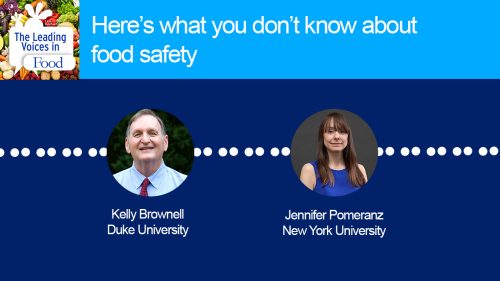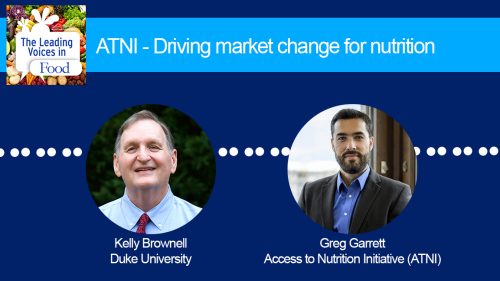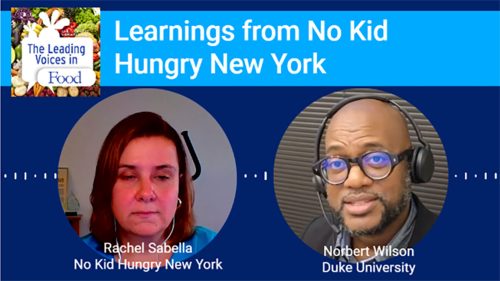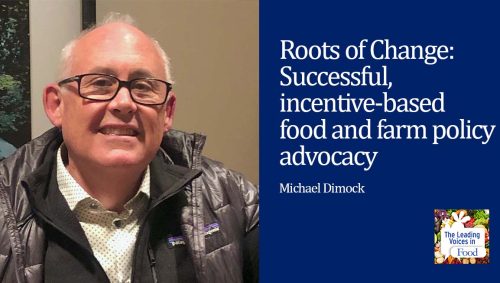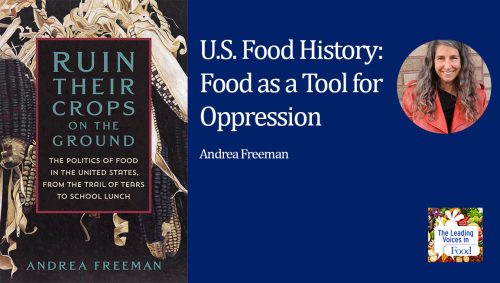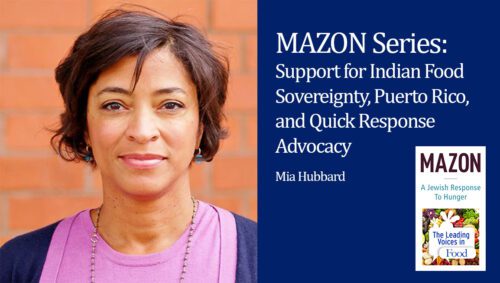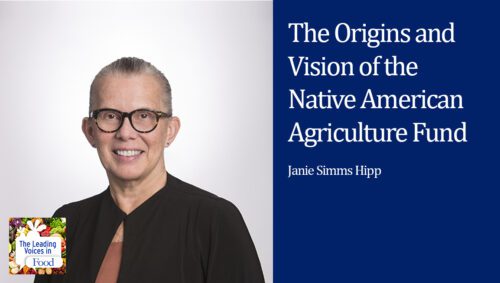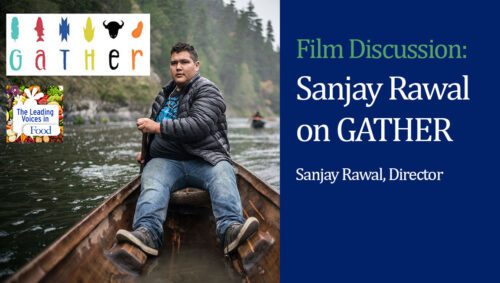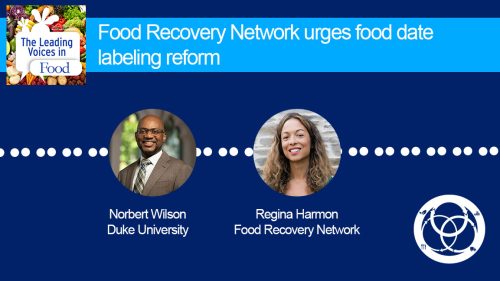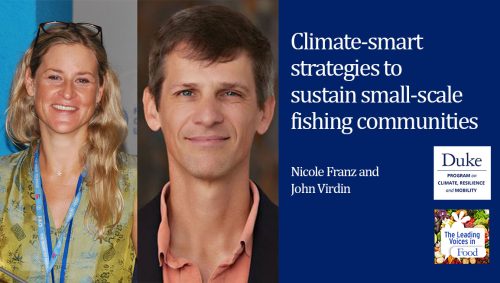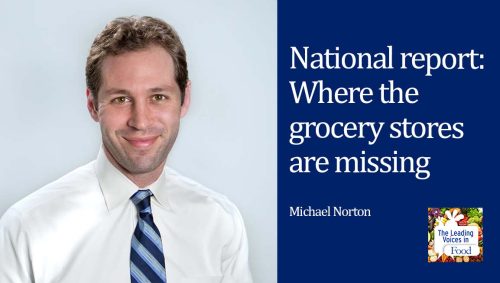The Leading Voices in Food
E122: Food RX Program Brings Helpful Changes to the Navajo
American Indians and Alaska natives face challenging economic, environmental, and political conditions that are in many ways similar to those experienced in developing countries. About 37%, for example, of Navajo or Dine people live in poverty. Access to preventive services such as cancer screening, immunizations, and early detection is often limited. And patients must travel long distances to obtain medical services. The situation is made worse by the lack of access to healthy foods. As a result, the life expectancy for American Indians is about six years shorter than that for the general population. Additionally, American Indians suffer disproportionately high rates of obesity, diabetes, heart disease, mental illness, and substance abuse. Today, we are speaking with two impressive people working to change that, Dr. Sonya Shin and Kymie Thomas. They run the Navajo Nation Community Outreach and Patient Empowerment or COPE Program. This is a community-based outreach and food security program made possible through a formal collaboration between Brigham and Women’s Health in Boston, Tribal Leadership and Indian Health Services to address health disparities in the Navajo Nation.
Subscribe: Apple Podcasts | TuneIN | YouTube Music | SoundCloud | PocketCasts | Radio Public
Tags: Diet & Nutrition | Equity, Race & Food Justice | First Nations Food Issues | Food Insecurity |

Dr. Sonya Shin, is a physician in the Division of Global Health Equity at Brigham and Woman’s Hospital and professor at Harvard School of Medicine. Her research and clinical experience has focused on relieving health issues among underserved populations. She has been working in Navajo Nation since 2009 and is the executive director and founder of Community Outreach and Patient Empowerment (COPE), a non-profit and Partners In Health sister organization that aims to eliminate health disparities and improve the wellbeing of American Indians and Alaska Natives through community-based outreach and food security initiatives.
Kymie Thomas is a member of the Navajo Nation, a coordinator for the COPE FVRx program and an aspiring Public Health professional. She earned a degree in Health Sciences from Sheridan College, and have 4 years’ experience working within the Public Health sector. As the Fruit and Vegetable Prescription Program Specialist for the COPE FVRx Program her work has allowed the COPE Program to help increase access to healthy foods for Navajo families, and improve health outcomes in various Navajo communities that are affected by diet related diseases.
Interview Summary
So Sonya, let me begin with you. As a physician at Brigham and Women’s Hospital and a professor at the Harvard School of Medicine, can you explain why you founded the COPE Program and the impact that it’s having?
I started off my work abroad doing global health. And as I began to learn about how to partner with communities to address health issues, I became really interested in turning my attention toward some of the issues that are facing our communities here in the United States. So we were just really excited and honored that about 10 years ago we were invited to partner with Navajo Nation. The idea was to really work in solidarity with the tribal leadership, with community partners, and health care providers to address some of the health disparities that you described before.
Kymie, I’d like to ask you as a member of the Navajo Nation, and the health professional and coordinator of the program, you’re in a unique position to help our leaders understand the experience of living in a food desert on a reservation. Can you describe more about this?
I grew up on the Navajo reservation, which is a larger reservation. It encompasses three states, New Mexico, Utah, and Arizona. The distance and traveling between the communities and to the nearest towns is about two hours. So within these communities, there’s a limited amount of grocery stores. People purchase foods in the convenience stores. And as you are all aware, most of the convenience stores typically only have processed foods and nutrient dense foods and they offer little to very little variety when it comes to fruits and vegetables. So with families living in a remote area, the delivery of these fruits and vegetables to these stores drives the cost of transportation to these families. So when they go in to purchase their food, they’re looking at foods that will last longer for their families, and some of the foods there aren’t very great quality. So most of the families have to travel more than two hours to be able to obtain these foods. My family didn’t have electricity until just recently. So in my family, we would have to travel into Gallup, which is for us a 45-minute drive. And we wouldn’t be able to purchase frozen fruits or vegetables, mainly fresh ones, but even then it wouldn’t last very long. So my parents would have to purchase foods that would last our family longer, so like potatoes and canned meats because you typically don’t need refrigeration for that type of food. And so I think for the people who live on the reservation, a pressing issue to not be able to purchase these healthy foods that we tell them to consume when they don’t have access to plumbing or electricity. So a lot of those factors combined really play a huge part in some of the challenges that our families face in obtaining healthy foods in a food desert.
So thank you for that description. Sonya, let me ask you, what is the COPE Program all about, and how does it go about trying to close these gaps for proper nutrition and while being centrally located in what’s this food desert that Kymie just described?
When we started the program, we weren’t actually thinking about addressing food insecurity. I was thinking about, okay, I’m a doctor, you know, how do I address diabetes? How are we going to be dealing with the rising rates of childhood obesity? But it became quickly apparent that a patient of mine with diabetes doesn’t need to be told that they’re supposed to eat fresher fruits and vegetables. They know this. And so we quickly became aware that in order to start to move the needle around some of these health issues, we were going to have to shift our focus from just trying to increase access to health care to also increasing access to healthy foods and actually making it possible for patients to make these changes that they want to make. We thought about it for some time and we listened to a lot of different partners. And what we heard is that on the one hand, really important to think about these individual families that are living deep in the reservation, oftentimes with very few options, but also to think about how do we create an approach that doesn’t just push all of the resources out to the border towns. So creating ways for people to travel outside of the reservation and spend their money, say, at a neighboring grocery store, it doesn’t actually change the actual status of the community on Navajo.
So we decided that the Fruit and Vegetable Prescription Program that Kymie runs might be an interesting approach for several reasons. One is that healthcare providers want to do something. When I see a patient in clinic and I know that they often don’t have healthy foods, especially after the first week of the month when they have fewer options, no electricity, et cetera, I want to be able to offer that family something. So engaging healthcare providers as implementers seemed very appealing. And then second, the idea of being able to use the vouchers that families receive to also kind of infuse economic stimulation to the local food system and the local economy was very appealing because that meant that over time, hopefully we could actually have a lasting impact on a more kind of thriving and robust food system.
You know, I would invite Kymie to describe a little bit more of that Fruit and Vegetable Prescription Program or FVRx as we call it. To us it seemed like a very interesting model for a cross-sectoral approach to address both the food system on Navajo Nation, and also health disparities.
Kymie, please do tell us more about the program.
We work closely with the providers addressing a family that’s in need. So finding that area where there is a need and locating those families and being able to work closely with our store team here in the organization to ensure that our partnering stores where sites are able to redeem vouchers, that they are also fully equipped with a wholesome variety of fruits and vegetables to be able to meet the selection from our voucher program, and not only for our participants, but basically anyone who comes into the stores to purchase food. You know, when they see that there is a bigger variety of fruits and vegetables, they’re more than likely going to be able to purchase that as opposed to just bananas and oranges that convenience stores normally have. And then also creating partnerships with our local growers so that families are aware that they can find vendors in their communities who sell locally grown produce. And another big emphasis is also incorporating more of our traditional foods back into our diets. So, you know, corn, fresh fruits, and vegetables like carrots, things that we have normally eaten just re-introducing that back into the diet as an indigenous community.
Sonya, is it too early to know what kind of impact this is having?
Well, we’re starting to generate impact. And I can describe some of the data that we’re seeing. We’re really interested in real world results as opposed to a clinical trial, but what we are seeing are, I think, pretty promising. So to give you a sense, we did ask that all of the clinics prioritize families with young kids. So either families with a pregnant mom or with a child that’s under age six. And we did that because we felt that the program would have the greatest impact on the health outcomes of that specific family. If we targeted really early in the life course of the child, it’s an opportunity where there’s a lot of positive and motivation for change, and families are very excited to make changes for their children. So that said, when we’ve looked at the families, not surprisingly, three quarters of the families are actually food insecure and that’s actually similar to other data that we’ve seen published about Navajo Nation. And after the six-month program, we’ve definitely been able to demonstrate that fruit and vegetable consumption is increasing among both the kids and the pregnant moms.
I think one of the things that’s most exciting of the data that we’ve seen is the change in the body mass index among the children. So we know that childhood obesity is associated with food insecurity. So it’s not surprising that we’re facing high rate of childhood obesity, as you mentioned before, Kelly. Among children who are enrolled with an initial weight that classifies them as overweight or obese, actually 38% of them achieved a healthy weight after six months. And I’m not a pediatrician, but I’ve been told by my colleagues who are running the program, that for them, it’s really one of the most impactful programs that they’ve had the opportunity to implement with their families. The other thing that we’re kind of interested in and we’re just starting to see some of this data now is the spillover effect that Kymie mentioned.
So a family can participate in the program for six months, but what we’re really after is changing the options out there at the community level for those families beyond the program. And then for all of the community members. So if there’s a small little convenience store or trading post, that’s really the only thing around for like say 60 miles, we want to change the variety, the options, the quality of the produce that’s available in those stores by driving up demand, and therefore bringing up supply. So we’ve actually looked at shoppers that are leaving these stores and compared stores that are part of this program to stores that are not participating. We’re seeing that just generic shoppers, so these aren’t people who are actually enrolled in the program, are actually purchasing more fruits and vegetables from participating stores. So our hope is that over time, if we can start to change the food environment at the community level, that we could actually have an even greater impact at the population level on some of these health issues.
You know, the number that you gave, two, or three quarters, rather, of households being food insecure is incredibly discouraging, but it’s really nice that you have such encouraging findings. It’s very impressive what you’re reporting so far. Let me ask you both a question. Sometimes relationships between organizations outside a community, like a university, and what goes on in the community, it doesn’t work very well or it’s very challenging to work through issues of trust and things like that. I’m curious from both of your points of view, how did you go about establishing trust, developing working relationships, creating a program that the community would actually embrace?
Having Navajo representation within the organization to help deliver the program has been really helpful. So I think with a lot of our families, it’s just reassuring to them seeing someone that is the same as them, you know, me being Navajo also, they’re comfortable with us coming out to families. And I think just us understanding and having that connection really has allowed the families to become more comfortable with the providers and the outside personnel. And there are some areas where a lot of the health professionals that make it up are also Native American or specifically Navajo. Just having someone similar to them and knowing, understanding where they’re coming from really helps them to embrace the fact that we are here to help them. We only want for them to be healthier and that we are hoping to establish a healthier nation. We are trying to change these health disparities. We are not necessarily trying to change their whole lifestyle, but more of just incorporating more fruits and vegetables, slower steps.
And Sonya, from your point of view, how do you see this process playing out and issues like trust working?
I’m glad you bring it up and I appreciate Kymie’s comments because I think it’s really key to any meaningful work when serving other communities. And I think Kymie’s testament to being a member of the Navajo Nation and being able to, not only build that trust as a frontline staff, but also given that opportunity to advance her own career and have the option of coming back and working in public health has been one of the important achievements of our organization.
I can say from my own standpoint as a provider and as somebody who is not from the community. With patients, it took me about four years to actually get any trust with the patients that I see in clinic because they’re so used to having providers come for about three years, which is about how long it takes to pay off your loans, and then to just cycle on out. And so I think there’s this important role of just being present, and constant, and really listening.
Most of our programs took a long time to germinate because we had to really just spend a fair amount of time listening to others and make sure that we were finding an approach or a strategy or a program that would respond to those needs and not actually become interventions that sort of circumvent or undermine other movements that are happening. You know, we spent a lot of time thinking about like, well, who’s in the food space? Who’s doing this kind of work? How can we not be the frontline providers, but how can we be the folks who are kind of infusing additional resources or ideas to build the capacity among folks who are already here in the community? I think that’s been a really important approach that we’ve taken over time. And it’s taken us 10 years to get this far. And, you know, I hope that the fact that we do have a fair amount of trust among providers and also with the Navajo Nation leadership, with whom we consult quite frequently, is kind of a testament to that approach of partnership.
Well, thank you. Kymie, I’d like to come back to you in just a moment and ask you about barriers that you encountered while the program was being implemented, but before I get to that, Sonya, do you believe that this is a model program that can be replicated elsewhere? And are you two working to get this program to other communities?
Yeah, I think from the very beginning, we were interested in choosing something that had the potential to be replicable to other Indigenous communities. And I should mention that FVRx, this Fruit and Vegetable Prescription Program is not unique. Like we’re not the only ones doing it. There are many different communities across the United States that offer prescription produce within healthcare settings. To our knowledge, this might be the only one being offered in a Native community, but from the very beginning, we’ve really tried to think about, okay, how can we create materials, generate evidence, think about flexibility that will allow the program if it’s successful to then be transmitted to other indigenous communities? And I know Kymie’s received a lot of interest and inquiries from other Tribes. I think the key take-home for us has been that every community has different strengths and different needs. And we’ve even seen that across Navajo. If we have 12 different clinics that are running the program, there’s a lot of heterogeneity of the program because each clinic has different teams that want to implement. They have different priorities, and they also have different gaps. So I think we’ve really tried to create a program that has parameters that are core, but has a lot of breathing room for flexibility and adaptation, so that our hope is it will be easier for other communities to take the model and then to say, “Okay, well, what’s going to work in our community? “What’s my priority here? “Who’s the team that I envision doing this work?” So that’s a future learning step for us too.
So Kymie, what are some of the barriers that you and your team encountered as you were implementing the program?
So as we are going across the reservation and implementing the program, we have started to notice a lot of good indicators of the work that we are doing. For instance, no bandwidth. Right now, we are a two-person team right now, and we are expanding to three, hopefully in the future. But, you know, with the increase in popularity of the program across the reservation, it’s hard to keep up with that demand. So finding the bandwidth to be able to keep the program and quality of the program going, it’s been really challenging. But it’s good that the program is growing and that we are needing extra hands.
And then also, just finding compatible platforms that work for everyone. So what might work here on a border town, because we have no internet capability, might not work for another clinic or another community health team that’s based six hours away, more in the middle of the reservation. So I think just finding compatible platforms to be able to communicate with everybody has been pretty difficult. And then, as the program is expanding, we are coming across other barriers, but they’re all a pretty good indicator of the growth that the program is seeing overall.

